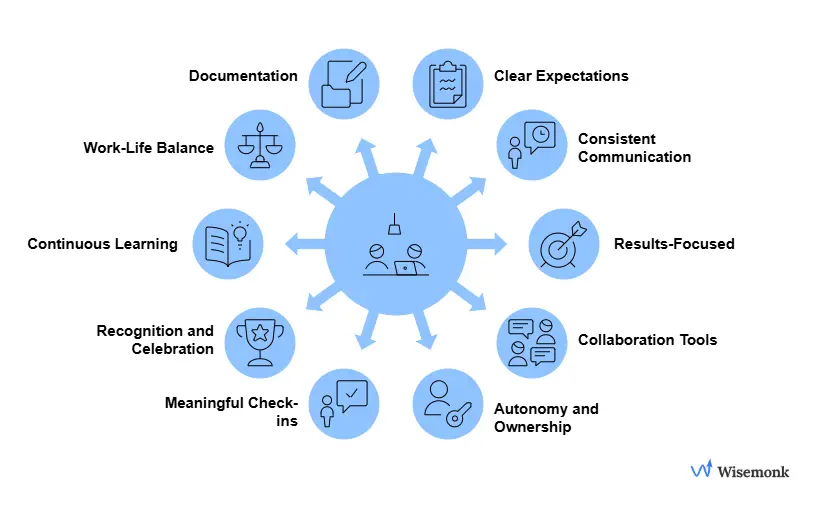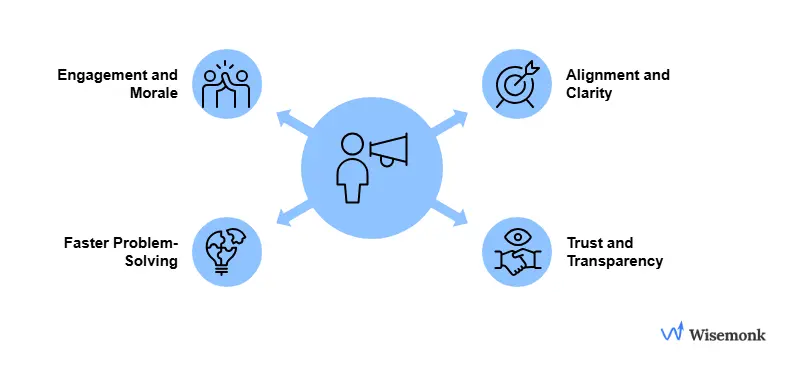- Managing remote workers means setting clear expectations, maintaining open communication, and using technology to stay aligned. Success comes from building trust, and encouraging balance.
- The key benefits of remote workers are increased productivity, access to global talent, and lower operational costs for companies. Employees also gain work-life balance, flexibility, and job satisfaction.
- The key challenges managers face with remote teams are communication barriers, data security risks, blurred work-life balance, and complex global payroll compliance.
- Incorporating key tools for managing remote teams streamlines operations while enhancing communication, collaboration, and project management. Together, they boost productivity and efficiency.
Ready to manage your remote team more effectively? Reach out to us today!
Discover how Wisemonk creates impactful and reliable content.
Looking for better ways to keep your remote team aligned, productive, and actually motivated? You’re in good company. Many U.S. businesses, founders, and global teams wrestle with how to manage remote workers without falling into micromanagement or burnout traps.
According to the U.S. Census Bureau, the share of U.S. workers who worked primarily from home jumped from 5.7% in 2019 to 17.9% in 2021, a threefold increase that completely redefined how teams operate. This massive shift forced companies to rethink management, collaboration, and culture for a world where “the office” is now everywhere.
That’s why understanding how to manage remote workers effectively has become a core leadership skill, not a nice-to-have. In this article, we’ll break down practical management strategies, proven frameworks, and the best tools you can use to lead remote teams with confidence and clarity. Let’s dive in.
How to manage remote workers?[toc=How to manage]
Effectively managing remote workers requires more than good communication, it needs structure, trust, and the right systems to keep teams productive and aligned.
With our experience running global payroll and compliance for remote teams, we know effective management comes from predictable processes, not micromanagement.
Here are the proven best practices that make managing remote workers effective, consistent, and performance-driven.

1. Set clear expectations early
Clarity is everything. Define what each role is responsible for, what outcomes matter most, and how success will be measured. When people know what “done” looks like, they stay focused and aligned, without needing constant reminders.
2. Build consistent communication rhythms
Remote teams fail when communication is random. Create predictable cadences like weekly team syncs, daily async updates, and open Slack threads. This structure keeps everyone informed, connected, and clear on priorities without endless meetings.
3. Focus on results, not hours worked
Remote work is about outcomes, not online time. Track deliverables, not desk presence. When managers trust people to manage their time, it builds ownership, confidence, and motivation, and ironically, leads to better results.
4. Use the right collaboration tools
Don’t overwhelm your team with too many apps. Use an integrated stack that combines chat, project tracking, and documentation, like Slack, Asana, or Notion. The goal is to make work seamless, not scattered.
5. Encourage autonomy and ownership
Give your team room to make decisions. Empowered people take pride in their work and solve problems faster. Micromanagement only slows progress and kills creativity.
6. Schedule meaningful check-ins
Check-ins shouldn’t just be task updates; they should be meaningful conversations that reflect the tone set by the company’s leadership. The best leaders listen more than they talk, ensuring their remote teams feel supported and aligned.
7. Recognize and celebrate wins
Remote work can feel invisible, so recognition matters. A quick Slack shoutout, a small reward, or even a personal message from leadership can make people feel valued and seen.
8. Support continuous learning
Give your team access to training programs, webinars, or mentorship. Remote professionals who grow their skills stay motivated, loyal, and aligned with company goals.
9. Encourage work-life balance
Don’t glorify overwork. Set boundaries and respect downtime. Encourage people to disconnect after hours, it’s how creativity and long-term performance stay intact.
10. Document everything important
In remote teams, memory fades fast. Document goals, processes, and decisions in one shared space. This prevents confusion, speeds up onboarding, and helps everyone stay on the same page.
According to the Bureau of Labor Statistics, a one-percentage-point rise in the share of remote workers across 61 U.S. industries (between 2019-21) is associated with a roughly 0.08-percentage-point increase in total factor productivity (TFP), suggesting remote work can meaningfully boost overall output when managed well.
Why is a flexible management style important for remote teams?[toc=Why it is Important]
A flexible management style isn’t about being soft, it’s about being smart. It means adjusting how you lead based on your team’s goals, time zones, and working styles instead of forcing everyone into one rigid mold.
Remote management success depends on many factors, time zones, work habits, trust levels, and how leaders handle change. Flexibility ties all of these together and keeps teams steady when everything else shifts.
Why flexibility makes remote management work:
- Different time zones: You can’t expect everyone to join a 9 AM call, not when “9 AM” means midnight for half the team. Smart managers shift schedules, not people’s lives.
- Diverse work habits: Some teammates do their best thinking at dawn, others after dinner. Flexibility lets them work when they’re most focused, and you’ll notice the quality difference.
- Autonomy and trust: When you stop policing hours and start trusting outcomes, people naturally take more ownership of their work.
- Crisis adaptation: Things go wrong, Wi-Fi drops, family emergencies happen. Flexible managers don’t panic; they problem-solve fast and keep momentum.
- Retention and morale: Remote pros stay where they’re trusted to do great work their way. Rigid control? That’s the fastest route to losing top talent.
According to Great Place To Work, a two-year study of over 1.3 million employees found that cooperation, not physical proximity, drives productivity in remote and hybrid settings, with remote-friendly companies outperforming traditional ones by nearly 42%.
How can you build strong relationships in a remote setup?[toc=Build Strong Relationships]
From supporting companies with HR operations and onboarding across borders, we’ve learned that remote relationships thrive when structure and empathy work hand in hand.
Here are three simple but powerful ways to build real connection and trust in a remote team:
- Communicate like you mean it: Remote teams don’t have hallway chats, so context is everything. When leaders take time to explain why decisions are made, people feel included instead of managed. Overcommunicate on goals, timelines, and expectations, it prevents misunderstandings and builds credibility.
- Celebrate small wins loudly: When everyone’s scattered across screens, appreciation often gets lost. A quick shoutout in Slack or a small recognition moment during a team call can do wonders for morale. It reminds people their work matters, even if no one’s watching them in an office.
- Make space for genuine conversations: Not every call needs an agenda. Casual check-ins or “virtual coffee” chats help teammates see each other as humans, not just job titles. Ask how they’re doing, not just what they’re doing, those simple moments create the trust that keeps remote teams together.
Strong remote relationships aren’t a matter of luck, they’re built through consistent communication methods, mutual trust, and thoughtful leadership. When new employees feel connected and respected, distance stops being a barrier to collaboration and performance.
Why is communication so critical when managing remote employees?[toc=Communication and Connection]
Clear communication is the glue that holds remote teams together. When physical distance separates people, effective communication channels like Slack, Zoom, and async updates become essential, words replace body language, and clarity replaces proximity.
Without it, even the best teams can slip into confusion, isolation, or duplicate effort. Here’s why strong communication is non-negotiable for remote managers:

- Alignment and clarity: Clear communication channels ensure everyone knows what success looks like, no guessing games, no mixed signals, and fewer gaps caused by physical distance.
- Trust and transparency: Regular, honest updates make employees feel included and valued, especially when decisions affect their work.
- Faster problem-solving: Open channels encourage people to raise issues early instead of letting small problems snowball.
- Engagement and morale: Frequent check-ins and thoughtful feedback help remote workers feel connected, not forgotten, directly improving employee satisfaction and team morale.
If communication gaps are slowing your remote team down, explore our in-depth guide on "Managing Remote Teams: Strategies and Tips".
How can you set clear expectations for remote team success?[toc=Expectations and Performance]
Through years of helping global companies set up compliant teams under EOR frameworks, we’ve realized that defined goals and transparent HR policies drive accountability more than supervision ever could.
Here’s how to set clear, measurable expectations that keep remote teams aligned and accountable.
- Set clear rules and expectations: Define roles, responsibilities, deadlines, and measurable outcomes right from the start. When people know exactly what’s expected, alignment and accountability follow.
- Focus on results, not hours: Great remote managers don’t track screen time, they track progress. Prioritize outcomes and deliverables instead of attendance; it builds trust and reduces friction.
- Track progress with tools: Use shared project management tools like Asana, Notion, or Trello to make progress visible to everyone. Transparency keeps teams aligned and helps identify roadblocks early.
Clear expectations turn remote work from chaos into coordination, when everyone knows the goal, the process, and the metrics, performance stops being managed and starts being owned.
What challenges do managers face with remote teams?[toc=Challenges Faced]
Having supported businesses through HR compliance, contractor classification, and payroll setups, we’ve seen the common pitfalls managers hit, visibility, alignment, and legal consistency across regions.
- Communication barriers: Without in-person cues, messages can easily be misinterpreted. Time zone gaps add friction, making it harder to keep discussions timely and productive. Managers need clear protocols and async tools to maintain flow.
- Data security risks: Global teams access company systems from different devices and networks, increasing the risk of breaches. Enforcing security protocols, training, and encryption tools is no longer optional, it’s essential.
- Work-life balance: The blurred line between home and work often leads to burnout. Encouraging boundaries, regular breaks, and realistic workloads keeps teams healthy and engaged.
- Payroll and compliance complexity: Paying and managing benefits for employees across multiple countries involves juggling tax laws, currencies, and labor codes. Automated payroll and EOR support simplify this dramatically.
To navigate these challenges effectively, managers need strong systems, clear communication frameworks, and trusted partners who can handle payroll, compliance, and HR operations across borders.
What are the best remote employee management tools to use?[toc=Tools to Use]
With hands-on experience integrating HR, payroll, and compliance systems for global teams, we’ve learned which tools truly help teams collaborate virtually and streamline remote operations, and company values.
Slack
Slack remains the most efficient tool for communication and team engagement in remote setups. Its real-time chat, channels, and video call features keep everyone connected while allowing async collaboration across time zones.
Key benefits:
- Streamlined communication: Centralize team discussions, updates, and project conversations.
- Async-friendly: Threads and mentions help maintain context without forcing real-time responses.
Google Workspace
Google Workspace provides everything a remote team needs to collaborate and share information securely, email, documents, spreadsheets, video calls, and cloud storage — all in one ecosystem.
Key benefits:
- Collaborate in real-time: Edit and comment simultaneously in Docs, Sheets, and Slides.
- Easy access anywhere: Securely store files in Drive and access them from any device, anytime.
Notion
Notion is the digital HQ for remote teams. It combines note-taking, project tracking, and documentation, letting teams centralize all their knowledge in one organized space.
Key benefits:
- All-in-one workspace: Replace scattered docs with structured project dashboards and wikis.
- Customizable workflows: Adapt pages and databases to match how your team actually works.
Asana
Asana helps remote teams stay organized and accountable. It lets you assign tasks, track progress visually, and ensure projects move forward without endless email threads.
Key benefits:
- Visual project tracking: Timeline and board views make deadlines and dependencies easy to follow.
- Automated workflows: Save time by automating routine project updates and reminders.
Zoom
Zoom remains the gold standard for reliable virtual meetings, from quick check-ins to all-hands gatherings. Its HD video and screen sharing features make collaboration feel more human — even from afar.
Key benefits:
- High-quality meetings: Stable, high-definition video for calls, webinars, and training sessions.
- Breakout rooms and recordings: Perfect for brainstorming, workshops, or async review later.
If you want to learn more about productivity tools for remote teams, explore our in-depth guide on the "10 Best Productivity Tools for Remote Teams".
What skills make someone a great remote manager?[toc=Skills needed for managers]
Working with companies to manage distributed teams and streamline HR operations, we’ve found that strong remote managers excel at empathy, process clarity, and cross-border collaboration.
Here are the key skills that separate good remote managers from great ones:
- Empathy and emotional intelligence: Behind every screen is a human being. The best leaders listen actively, understand personal challenges, and build psychological safety.
- Organizational skills: Managing remote teams requires balancing multiple time zones, tools, and workflows, organization keeps everyone on track.
- Tech proficiency: Knowing how to use project management tools, video conferencing platforms, and HR systems ensures seamless collaboration in a virtual environment.
- Trust building: Without in-person supervision, trust is everything. Consistency, transparency, and follow-through make remote employees feel confident and respected.
- Coaching mindset: Remote managers who focus on mentoring, not micromanaging, create self-driven, high-performing teams.
Leading a remote team takes more than management, it takes clarity, empathy, and the ability to connect across distance. When those skills align, remote teams don’t just function, they thrive.
How Wisemonk helps companies effortlessly manage and scale remote teams?[toc=How Wisemonk Helps]
Wisemonk is a trusted Employer of Record (EOR) and Professional Employer Organization (PEO) partner in India that helps global companies hire, pay, and manage remote talent without the operational or legal complexity.
Here’s how we help you manage and scale your remote workforce:
- End-to-end employee management: We handle onboarding, contracts, background verification, and local documentation, ensuring every remote employee starts strong and stays compliant.
- Payroll and compliance automation: We manage multi-country payroll, taxes, and statutory benefits like PF, ESI, and gratuity with full accuracy and transparency.
- Equipment procurement and setup: Wisemonk ensures your remote team has the right tools and hardware from day one, delivered, tracked, and supported.
- Local HR operations: From attendance tracking to leave management and employee queries, we provide ongoing HR support tailored to India’s labor framework.
Ready to scale your remote team effortlessly? Book a free consultation today to learn how we can help you build, pay, and manage top talent, faster, safer, and smarter.
.webp)






